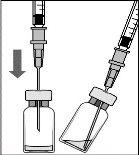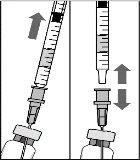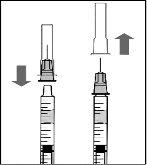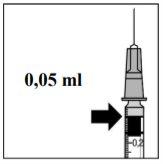
РИММІРА 10 мг/мл РОЗЧИН ДЛЯ ІН'ЄКЦІЙ

Інструкція із застосування РИММІРА 10 мг/мл РОЗЧИН ДЛЯ ІН'ЄКЦІЙ
Вступ
Опис: інформація для пацієнта
Ріммірах 10 мг/мл ін'єкційне рішення
ранібізумаб
Цей лікарський засіб підлягає додатковому моніторингу, що прискорить виявлення нової інформації про його безпеку. Ви можете допомогти, повідомивши про будь-які побічні ефекти, які ви можете мати. Остання частина розділу 4 містить інформацію про те, як повідомляти про ці побічні ефекти.
Прочитайте уважно весь опис перед тим, як вам буде введено цей лікарський засіб, оскільки він містить важливу інформацію для вас.
- Збережіть цей опис, оскільки вам може знадобитися знову його прочитати.
- Якщо у вас є якісь питання, проконсультуйтеся з вашим лікарем.
- Якщо ви відчуваєте побічні ефекти, проконсультуйтеся з вашим лікарем, навіть якщо це побічні ефекти, які не вказані в цьому описі. Див. розділ 4.
Зміст опису
- Що таке Ріммірах і для чого він використовується
- Що вам потрібно знати перед тим, як вам буде введено Ріммірах
- Як вводиться Ріммірах
- Можливі побічні ефекти
- Збереження Рімміраху
- Зміст упаковки та додаткова інформація
1. Що таке Ріммірах і для чого він використовується
Що таке Ріммірах
Ріммірах - це рішення для ін'єкцій в око. Ріммірах належить до групи лікарських засобів, званих антинеоваскулярними агентами. Він містить активну речовину під назвою ранібізумаб.
Для чого використовується Ріммірах
Ріммірах використовується у дорослих для лікування кількох офтальмологічних захворювань, які викликають порушення зору.
Ці захворювання є результатом пошкодження сітківки (чутливої до світла частини в задній частині ока), викликаного:
- Ростом аномальних судин, які втрачають рідину. Це спостерігається при захворюваннях, таких як вікова макулярна дегенерація (ВМД) та проліферативна діабетична ретинопатія (ПДР, захворювання, викликане цукровим діабетом). Це також може бути пов'язано з хоріоїдальною неоваскуляризацією (ХНВ) через патологічну міопію (ПМ), ангіоїдні стрії, центральну серозну хоріоретинопатію або ХНВ-інфламацію.
- Макулярним едемом (збільшенням центру сітківки). Причина цього збільшення може бути цукровим діабетом (захворюванням, відомим як діабетичний макулярний едем (ДМЕ)) або блокуванням ретинальних вен сітківки (захворюванням, відомим як оклюзія ретинальної вени (ОРВ)).
Як діє Ріммірах
Ріммірах впізнає і зв'язується з конкретним білком, званим фактором росту ендотелію судин А (VEGF-A), який присутній в очах. У надмірній кількості VEGF-A викликає рост аномальних судин і збільшення в оці, що може викликати порушення зору при захворюваннях, таких як ВМД, ДМЕ, ПДР, ОРВ, ПМ та ХНВ. Завдяки зв'язуванню з VEGF-A Ріммірах може запобігти його дії і попередити такий аномальний рост і збільшення.
При цих захворюваннях Ріммірах може допомогти стабілізувати і, у багатьох випадках, покращити зір.
2. Що вам потрібно знати перед тим, як вам буде введено Ріммірах
Ріммірах не повинен бути введений вам
- Якщо ви алергічні на ранібізумаб або на будь-який інший компонент цього лікарського засобу (перелічені в розділі 6).
- Якщо у вас є інфекція в оці або навколо нього.
- Якщо у вас є біль або червоність (важка внутрішньоочна інфламація) в оці.
Попередження та застереження
Проконсультуйтеся з вашим лікарем перед тим, як вам буде введено Ріммірах
- Ріммірах вводиться шляхом ін'єкції в око. Іноді після лікування Ріммірахом може виникнути інфекція всередині ока, біль або червоність (внутрішньоочна інфламація), відшарування або розрив однієї з шарів, розташованих на дні ока (відшарування або розрив сітківки і відшарування або розрив пігментного епітелію сітківки), або закляття кришталика (катаракта). Відразу повідомте вашому лікареві про будь-які ознаки, такі як біль в оці або збільшення дискомфорту в оці, якщо погіршується червоність в оці, розмита зір або зниження зору, збільшення кількості малих плям у зорі або збільшення чутливості до світла.
- У деяких пацієнтів після ін'єкції тиск в оці може збільшитися протягом короткого періоду часу. Можливо, ви не будете помічати цього, тому ваш лікар може проводити моніторинг окулярного тиску після кожної ін'єкції.
- Повідомте вашому лікареві, якщо у вас були захворювання очей або якщо ви раніше отримували лікування очей, або якщо у вас був інсульт або якщо у вас були тимчасові ознаки інсульту (слабкість або параліч члена або обличчя, труднощі з мовою або розумінням). Ця інформація буде врахована для оцінки того, чи є Ріммірах відповідним лікуванням для вас.
Для отримання більш детальної інформації про побічні ефекти, які можуть виникнути під час лікування Ріммірахом, див. розділ 4 («Можливі побічні ефекти»).
Діти та підлітки (до 18 років)
Використання Рімміраху в дітей та підлітках не рекомендується, оскільки його ефективність та безпека не встановлені в цих вікових групах.
Інші лікарські засоби та Ріммірах
Повідомте вашому лікареві, якщо ви використовуєте, нещодавно використовували або можете використовувати будь-які інші лікарські засоби.
Вагітність та лактація
- Жінки, які можуть завагітніти, повинні використовувати ефективний метод контрацепції під час лікування та протягом至少 трьох місяців після останньої ін'єкції Рімміраху.
- Немає досвіду використання Рімміраху у вагітних жінок. Ріммірах не повинен бути використаний під час вагітності, якщо тільки потенційна користь не переважає потенційний ризик для плода. Якщо ви вагітні, вважаєте, що можете бути вагітною або плануєте завагітніти, проконсультуйтеся з вашим лікарем перед лікуванням Ріммірахом.
- Малі кількості ранібізумабу можуть потрапляти до грудного молока, тому не рекомендується використання Рімміраху під час лактації. Проконсультуйтеся з вашим лікарем або фармацевтом перед лікуванням Ріммірахом.
Водіння транспортних засобів та використання машин
Після лікування Ріммірахом ви можете тимчасово відчувати розмиту зір. Якщо це відбувається, не водьте транспортні засоби та не використовуйте машини, поки цей симптом не зникне.
3. Як вводиться Ріммірах
Ріммірах вводиться офтальмологом у вигляді однієї ін'єкції в око під місцевою анестезією. Звичайна доза однієї ін'єкції становить 0,05 мл (що містить 0,5 мг ранібізумабу). Інтервал між двома дозами, введеними в одне око, повинен бути не менше чотирьох тижнів. Всі ін'єкції будуть введені офтальмологом.
Для попередження інфекції перед ін'єкцією ваш лікар буде ретельно мити око. Ваш лікар також введе місцевий анестетик, щоб зменшити або попередити будь-який біль, який ви можете відчувати під час ін'єкції.
Лікування починається з однієї ін'єкції Рімміраху кожний місяць. Ваш лікар буде контролювати захворювання вашого ока і залежно від того, як ви реагуєте на лікування, вирішить, чи потрібно вам продовжувати лікування та коли вам потрібно буде повторне лікування.
У кінці опису наведені детальні інструкції з використання.
Пацієнти похилого віку (від 65 років)
Ріммірах може бути використаний у осіб від 65 років, і не потрібно коригування дози.
Перед тим, як припинити лікування Ріммірахом
Якщо ви плануєте припинити лікування Ріммірахом, відвідайте наступний прийом і обговоріть це з вашим лікарем перед тим. Ваш лікар порадить вам і вирішить, протягом якого часу вам потрібно буде продовжувати лікування Ріммірахом.
Якщо у вас є якісь інші питання щодо використання цього лікарського засобу, проконсультуйтеся з вашим лікарем.
4. Можливі побічні ефекти
Як і всі лікарські засоби, цей лікарський засіб може викликати побічні ефекти, хоча не всі люди їх відчувають.
Побічні ефекти, пов'язані з введенням Рімміраху, можуть бути викликані самим лікарським засобом або процедурою ін'єкції, і більшість з них впливають на око.
Нижче описані найбільш серйозні побічні ефекти:
Серйозні побічні ефекти часто(можуть виникнути у до 1 з 10 осіб):
- Відшарування або розрив однієї з шарів у внутрішній частині ока (відшарування або розрив сітківки), що призводить до появи світлих плям з плаваючими частинками, які прогресують до тимчасової втрати зору або до закляття кришталика (катаракти).
Серйозні побічні ефекти рідко(можуть виникнути у до 1 з 100 осіб):
- Сліпота, інфекція очного яблука (ендофтальміт) з інфламацією внутрішньої частини ока.
Симптоми, які ви можете відчувати, включають біль або збільшення дискомфорту в оці, якщо погіршується червоність в оці, розмита зір або зниження зору, збільшення кількості малих плям у зорі або збільшення чутливості до світла.
Повідомте вашому лікареві негайно, якщо ви відчуваєте будь-який з цих побічних ефектів.
Нижче описані найбільш часто повідомлені побічні ефекти:
Часті побічні ефекти часто(можуть виникнути у більш ніж 1 з 10 осіб)
Очні побічні ефекти включають:
- Інфламацію ока,
- Кровотечу в задній частині ока (геморагію в сітківці),
- Зміни зору,
- Біль в оці,
- Малі частинки або плями в зорі (плаваючі частинки),
- Кров в оці,
- Іритацію ока,
- Чуття чогось в оці,
- Збільшення виділення сльози,
- Інфламацію або інфекцію на краю повік,
- Сухість ока,
- Червоність або свербіж в оці,
- Збільшення тиску в оці.
Неочні побічні ефекти включають:
- Біль у горлі,
- Носова конгестія,
- Носовий секрет,
- Головний біль,
- Біль у суглобах.
Нижче описані інші побічні ефекти, які можуть виникнути після лікування Ріммірахом:
Часті побічні ефекти часто(можуть виникнути у до 1 з 10 осіб)
Очні побічні ефекти включають:
- Зниження ясності зору,
- Збільшення однієї з частин ока (увеї, рогівки),
- Інфламацію рогівки (передньої частини ока),
- Малі пошкодження поверхні ока,
- Розмиту зір,
- Кровотечу в місці ін'єкції,
- Кровотечу в оці,
- Секрецію ока з свербіжем,
- Червоність та збільшення (кон'юнктивіт),
- Чутливість до світла,
- Дискомфорт в оці,
- Збільшення повіка,
- Біль у повіці.
Неочні побічні ефекти включають:
- Інфекцію сечовивідних шляхів,
- Низький рівень червоних кров'яних тільців (з симптомами, такими як втома, труднощі з диханням, головокружіння, блідість),
- Тривогу,
- Кашель,
- Нудоту,
- Алергічні реакції, такі як висип, кропив'янка, свербіж та червоність шкіри.
Рідкі побічні ефекти рідко(можуть виникнути у до 1 з 100 осіб)
Очні побічні ефекти включають:
- Інфламацію та кровотечу в передній частині ока,
- Нагромадження гною в оці,
- Зміни в центральній частині поверхні ока,
- Біль або свербіж в місці ін'єкції,
- Аномальне чуття в оці,
- Іритацію повіка.
Повідомлення про побічні ефекти
Якщо ви відчуваєте будь-який побічний ефект, повідомте вашому лікареві, навіть якщо це побічні ефекти, які не вказані в цьому описі. Ви також можете повідомити про них безпосередньо через національну систему повідомлення, включену до додатку V. Повідомлення про побічні ефекти допоможе надати більше інформації про безпеку цього лікарського засобу.
5. Збереження Рімміраху
- Тримайте цей лікарський засіб поза зоною досяжності дітей.
- Не використовуйте цей лікарський засіб після закінчення терміну придатності, вказаного на коробці після CAD та на етикетці флакона після EXP. Термін придатності - останній день місяця, який вказано.
- Тримайте в холодильнику (між 2°C та 8°C). Не заморожуйте.
- Перед використанням невідкритий флакон можна тримати при кімнатній температурі (25°C) протягом максимум 24 годин.
- Тримайте флакон в зовнішній упаковці, щоб захистити його від світла.
- Не використовуйте жодну упаковку, яка пошкоджена.
6. Зміст упаковки та додаткова інформація
Склад Рімміра
- Активний інгредієнт - ранібізумаб. Кожен мл містить 10 мг ранібізумабу. Кожна флакон містить 2,3 мг ранібізумабу в 0,23 мл розчину. Це забезпечує достатню кількість для надання одноразової дози 0,05 мл, яка містить 0,5 мг ранібізумабу.
- Інші компоненти - трегалоза дигідрат, гідрохлорид гістидину моногідрат, гістидин, полісорбат 20 (Е432), вода для ін'єкцій.
Вигляд продукту та вміст упаковки
Ріммірах - ін'єкційний розчин, який міститься у флаконі (0,23 мл). Розчин прозорий або легенько опалесцентний, безбарвний або коричневий, водянистий.
Існують два різних типи упаковок:
Упаковка тільки з флаконом
Упаковка, яка містить скляний флакон з ранібізумабом, з пробкою з хлоробутілу. Флакон призначений для одноразового використання.
Упаковка флакону + голки з фільтром
Упаковка, яка містить скляний флакон з ранібізумабом, з пробкою з хлоробутілу та тупу голку з фільтром (18G x 1 1/2 дюйма, 1,2 мм x 40 мм, 5 мкм) для витягування вмісту флакону. Всі компоненти призначені для одноразового використання.
Власник дозволу на продаж
QILU PHARMA SPAIN S.L.
Paseo de la Castellana 40, 8-й поверх
28046 Мадрид
Іспанія
Виробник
KYMOS, S.L.
Ronda De Can Fatjo 7 B
Parc Tecnologic Del Valles
Cerdanyola Del Valles
Барселона
08290
Іспанія
Відвідувачі можуть звернутися за додатковою інформацією про цей препарат до місцевого представника власника дозволу на продаж:
Бельгія/Бельгія/Бельгія Qilu Pharma Spain S.L. Тел./Телефон: + 34 911 841 918 | Литва Qilu Pharma Spain S.L. Телефон: + 34 911 841 918 |
Qilu Pharma Spain S.L. Тел.: + 34 911 841 918 | Люксембург/Люксембург Qilu Pharma Spain S.L. Тел./Телефон: + 34 911 841 918 |
Чехія Qilu Pharma Spain S.L. Телефон: +34 911 841 918 | Угорщина Qilu Pharma Spain S.L. Телефон: +34 911 841 918 |
Данія Orion Pharma A/S Телефон: +45 8614 00 00 | Мальта Qilu Pharma Spain S.L. Телефон: +34 911 841 918 |
Німеччина Orion Pharma GmbH Телефон: +49 40 899 689-0 | Нідерланди Orion Pharma BV/SRL Телефон: +32 (0)15 64 10 20 |
Естонія Qilu Pharma Spain S.L. Телефон: +34 911 841 918 | Норвегія Orion Pharma AS Телефон: +47 4000 42 10 |
Греція Orion Pharma Hellas М.Ε.П.Ε. Телефон: + 30 210 980 3355 | Австрія Qilu Pharma Spain S.L. Телефон: +34 911 841 918 |
Іспанія Orion Pharma SL Телефон: +349 159 9 86 01 | Польща Orion Pharma Poland Sp. z o. o. Телефон: + 48 22 833 31 77 |
Франція Orion Pharma Телефон: +33 (0) 1 85 18 00 00 | Португалія Orionfin Unipessoal Lda. Телефон: +351 211 546 820 |
Хорватія Qilu Pharma Spain S.L. Телефон: +34 911 841 918 | Ірландія Qilu Pharma Spain S.L. Телефон: +34 911 841 918 |
Румунія Qilu Pharma Spain S.L. Телефон: +34 911 841 918 | Словенія Qilu Pharma Spain S.L. Телефон: +34 911 841 918 |
Ісландія Qilu Pharma Spain S.L. Телефон: + 34 911 841 918 | Словаччина Qilu Pharma Spain S.L. Телефон: + 34 911 841 918 |
Італія Orion Pharma S.r.l. Телефон: + 39 02 67876111 | Фінляндія Orion Pharma Телефон: +358 10 4261 |
Кіпр Qilu Pharma Spain S.L. Телефон: + 34 911 841 918 | Швеція Orion Pharma AB Телефон: + 46 8 623 6440 |
Латвія Qilu Pharma Spain S.L. Телефон: +34 911 841 918 | Велика Британія (Північна Ірландія) Orion Pharma (Ірландія) Limited Телефон: +353 1 428 7777 |
Дата останнього перегляду цього посібника:
Інші джерела інформації
Детальна інформація про цей препарат доступна на сайті Європейського агентства з лікарських засобів: http://www.ema.europa.eu.
ЦЯ ІНФОРМАЦІЯ ПРИДНАЗНАЧЕНА ТІЛЬКИ ДЛЯ МЕДИЧНИХ СПЕЦІАЛІСТІВ:
Див. також розділ 3 «Як застосовувати Ріммірах».
Флакон для одноразового використання. Лише для внутрішньоочкового застосування.
Ріммірах повинен бути застосованийoftalmологом, який має досвід застосування внутрішньоочкових ін'єкцій.
У разі екзудативної вікової макулярної дегенерації, нововутворення судинної оболонки, розсіяного ретинального захворювання та порушення зору, викликані макулярним едемом або оклюзією венозної гілки сітниці, рекомендована доза Рімміраху становить 0,5 мг, введену у вигляді одноразової внутрішньоочкової ін'єкції. Це відповідає об'єму ін'єкції 0,05 мл. Інтервал між двома ін'єкціями, введеними в одне й те саме око, повинен бути не менше чотирьох тижнів.
Лікування починається з одноразової ін'єкції на місяць до досягнення максимальної остроти зору та/або відсутності ознак активності захворювання, тобто жодних змін остроти зору чи інших ознак і симптомів захворювання під час тривалого лікування. У пацієнтів з екзудативною віковою макулярною дегенерацією, макулярним едемом, розсіяним ретинальним захворюванням та оклюзією венозної гілки сітниці спочатку можуть знадобитися три або більше послідовних ін'єкцій, введених щомісяця.
Після цього моменту інтервали спостереження та лікування повинні визначатися за медичними критеріями та на основі активності захворювання, оцінюваної за допомогою остроти зору та/або анатомічних параметрів.
Лікування Ріммірахом повинно бути припинено, якщо за медичним критерієм візуальні та анатомічні параметри вказують на те, що пацієнт не отримує користі від тривалого лікування.
Спостереження за активністю захворювання може включати клінічний огляд, функціональний контроль або методи візуалізації (наприклад, оптичну когерентну томографію або ангіографію з флуоресцеїном).
Якщо пацієнтів лікувати згідно з режимом «лікувати та продовжувати», після досягнення максимальної остроти зору та/або відсутності ознак активності захворювання інтервали лікування можна поступово збільшувати до тих пір, поки знову не з'являться ознаки активності захворювання або порушення зору. У разі екзудативної вікової макулярної дегенерації інтервал лікування не повинен збільшуватися більш ніж на дві тижні кожний раз, а у разі макулярного едему - до одного місяця кожний раз. Для розсіяного ретинального захворювання та оклюзії венозної гілки сітниці інтервали лікування також можна поступово збільшувати, однак наявні дані недостатні для визначення тривалості цих інтервалів. Якщо знову з'являються ознаки активності захворювання, інтервал лікування повинен бути скорочений.
Лікування порушення зору, викликаного нововутненням судинної оболонки, повинно визначатися для кожного пацієнта індивідуально на основі активності захворювання. Деяким пацієнтам може знадобитися лише одна ін'єкція протягом перших 12 місяців; іншим пацієнтам може знадобитися лікування з більшою частотою, включаючи щомісячну ін'єкцію. У разі нововутнення судинної оболонки, викликаного патологічною міопією, багатьом пацієнтам може знадобитися лише одна чи дві ін'єкції протягом першого року.
Ранібізумаб і лазерна фотокоагуляція при макулярному едемі та едемі, викликаному оклюзією венозної гілки сітниці
Існує деякий досвід застосування ранібізумабу разом з лазерною фотокоагуляцією. Коли вони застосовуються в один і той же день, ранібізумаб повинен бути застосований не менше ніж за 30 хвилин після лазерної фотокоагуляції. Ранібізумаб можна застосовувати у пацієнтів, які раніше отримували лазерну фотокоагуляцію.
Ранібізумаб і фотодинамічна терапія з вертепорфіном при нововутненні судинної оболонки, викликаному патологічною міопією
Немає досвіду застосування ранібізумабу разом з вертепорфіном.
Перед застосуванням Рімміраху лікарський засіб повинен бути візуально перевірений на відсутність частинок, забарвлення чи зміни. Якщо виявлені частинки, забарвлення чи зміни, флакон повинен бути видалений згідно з місцевими правилами утилізації.
Процедура ін'єкції повинна проводитися в умовах асептики, які включають хірургічний душ, використання стерильних рукавичок, стерильне поле, стерильний блефаростат (або еквівалент) та наявність стерильної парацентези (за необхідності). Перед проведенням процедури внутрішньоочкової ін'єкції повинна бути детально оцінена клінічна історія пацієнта щодо гіперчутливості. Перед ін'єкцією повинна бути застосована адекватна анестезія та широкоспектральний мікробіцид для дезінфекції шкіри навколо очей, повік та поверхні ока згідно з місцевою практикою.
Упаковка тільки з флаконом
Флакон призначений для одноразового використання. Після ін'єкції будь-який залишковий незастосований продукт повинен бути видалений. Не слід використовувати жоден флакон, який показує ознаки пошкодження або порушення.
Для підготовки та внутрішньоочкової ін'єкції необхідні наступні медичні засоби (для одноразового використання):
- голка з фільтром 5 мкм (18G x 1 1/2 дюйма, 1,2 мм x 40 мм)
- стерильна шприц 1 мл (з маркуванням 0,05 мл)
- голка для ін'єкції (30G x 1/2 дюйма). Ці медичні засоби не входять до складу упаковки Рімміраху.
Упаковка флакону + голки з фільтром
Всі компоненти стерильні та призначені для одноразового використання. Не слід використовувати жоден компонент, упаковка якого показує ознаки пошкодження або порушення. Стерильність може бути гарантована лише у разі збереження цілісності упаковки компонентів.
Для підготовки та внутрішньоочкової ін'єкції необхідні наступні медичні засоби для одноразового використання:
- голка з фільтром 5 мкм (18G x 1 1/2 дюйма, 1,2 мм x 40 мм, 5 мкм, надана)
- стерильна шприц 1 мл (з маркуванням 0,05 мл, не входить до складу упаковки Рімміраху)
- голка для ін'єкції (30G x 1/2 дюйма, 0,3 мм x 13 мм, не входить до складу упаковки Рімміраху)
Для підготовки Рімміраху до внутрішньоочкової ін'єкції у дорослих пацієнтів слід виконувати наступні інструкції:
Відстежуваність
Для покращення відстежуваності біологічних лікарських засобів ім'я та номер партії лікарського засобу, який було застосовано, повинні бути чітко зареєстровані.
|
гому флакону повинна бути дезінфікована (наприклад, ватним тампоном з алкоголем 75%). |
|
Вставити тупу голку з фільтром у центр пробки флакону до тих пір, поки голка не торкнеться нижнього кінця флакону.
Примітка: Тримати голку для ін'єкції за конус, коли знімається кришка.
Примітка: Не висушувати голку для ін'єкції. Не тягнути поршень назад. |
Голка для ін'єкції повинна бути введена на 3,5-4,0 мм позаду лімба в скловидне тіло, щоб уникнути горизонтального меридіана, а голка повинна бути направлена до центру очного яблука. Потім повинен бути введений об'єм ін'єкції 0,05 мл. Для наступних ін'єкцій повинна бути використана інша локалізація склери.
Після ін'єкції не закривати голку кришкою та не відокремлювати її від шприца. Видалити використаний шприц разом з голкою у контейнер для колючих предметів або згідно з місцевими правилами.
- Країна реєстрації
- Діючі речовини
- Потрібен рецептТак
- Виробник
- СкладPOLISORBATO 20 (0,023 mg mg)
- Інформація є довідковою і не є медичною порадою. Перед прийомом будь-яких препаратів обов'язково проконсультуйтеся з лікарем. Oladoctor не несе відповідальності за медичні рішення, прийняті на основі цього контенту.
- Альтернативи до РИММІРА 10 мг/мл РОЗЧИН ДЛЯ ІН'ЄКЦІЙФорма випуску: РОЗЧИН ДЛЯ ІН'ЄКЦІЙ, 10 мг/млДіючі речовини: ranibizumabВиробник: Samsung Bioepis Nl B.V.Потрібен рецептФорма випуску: РОЗЧИН ДЛЯ ІН'ЄКЦІЙ, 10 мг/млДіючі речовини: ranibizumabВиробник: Novartis Europharm LimitedПотрібен рецептФорма випуску: РОЗЧИН ДЛЯ ІН'ЄКЦІЙ, 10 мг/млДіючі речовини: ranibizumabВиробник: Novartis Europharm LimitedПотрібен рецепт








